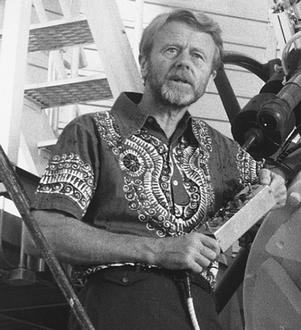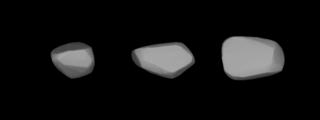
Henry Abraham Wassenbergh (Hattem, Gelderland, 16 August 1924 - 1 February 2014), known to his friends and colleagues as "Or" Wassenbergh, was a Dutch academic, professor of law, and writer.

Henry Abraham Wassenbergh (Hattem, Gelderland, 16 August 1924 - 1 February 2014), known to his friends and colleagues as "Or" Wassenbergh, was a Dutch academic, professor of law, and writer.
Wassenbergh earned a law degree from the University of Amsterdam in 1950. He studied international law at the Sorbonne and at the Institute of Higher International Studies in Paris, France; and continued his studies in the Netherlands, earning a doctorate from the University of Leiden in 1957. [1]
From 1950 through 1989, Wassenbergh was an official of Royal Dutch Airlines (KLM). [2]
Since 1967, he had been a member of the Air Transport Commission of the International Chamber of Commerce in Paris. Wassenbergh also participated in the European Centre for Space Law (ECSL) of the European Space Agency (ESA), the International Institute of Space Law of the International Astronautical Federation, the International Air Transport Association (IATA) Air Policy Advisory Group, the Société Française de Droit Aerién, the Netherlands branch of the Legal Committee of the International Civil Aviation Organization, and the Netherlands Interdepartmental Committee on Civil Aviation. [1] In this context, the title of one of his books seems prescient -- Principles of Outer Space Law in Hindsight. [3]
5756 Wassenbergh (6034 P-L) is a main-belt asteroid discovered on September 24, 1960 by Cornelis Johannes van Houten, Ingrid van Houten-Groeneveld and Tom Gehrels at Palomar Observatory. [2]
This minor irregularly-shaped planetary body was named for Wassenbergh, who was Professor of Air and Space Law at University of Leiden from 1977 through 1994. The permanent designation was suggested by Prof. Wassenbergh's secretary and his colleagues at Leiden; and the announcement of this name was timed to coincide with his valedictory address at the university. [2] He had been Professor Extraordinarius of Air and Space Law at Leiden since 1977, and Professor Ordinarius since 1991. [1]

Anton M.J. "Tom" Gehrels was a Dutch–American astronomer, Professor of Planetary Sciences, and Astronomer at the University of Arizona, Tucson.

Ingrid van Houten-Groeneveld was a Dutch astronomer.
Cornelis Johannes van Houten was a Dutch astronomer, sometimes referred to as Kees van Houten.
1869 Philoctetes is a Jupiter trojan from the Greek camp, approximately 23 kilometers in diameter.

9910 Vogelweide, provisional designation 3181 T-2, is a stony Koronian asteroid and elongated slow rotator from the outer regions of the asteroid belt, approximately 5 kilometers in diameter. It was discovered during the second Palomar–Leiden trojan survey in 1973, and named after German medieval poet Walther von der Vogelweide.

9909 Eschenbach, provisional designation 4355 T-1, is a Florian asteroid from the inner regions of the asteroid belt, roughly 10 kilometers in diameter.
6805 Abstracta, provisional designation 4600 P-L, is a carbonaceous Themistian asteroid and slow rotator from the outer region of the asteroid belt, approximately 10 kilometers in diameter.

1873 Agenor is a dark Jupiter trojan from the Trojan camp, approximately 53 kilometers in diameter. It was discovered during the Palomar–Leiden Trojan survey in 1971, and later named after Agenor from Greek mythology. The dark Jovian asteroid belongs to the 100 largest Jupiter trojans and has a rotation period of 20.60 hours.
1846 Bengt, provisional designation 6553 P-L, is a dark asteroid from the inner regions of the asteroid belt, approximately 11 kilometers in diameter. Discovered by the Palomar–Leiden survey in 1960, it was named for Danish astronomer Bengt Strömgren.
1870 Glaukos is a mid-sized Jupiter trojan from the Trojan camp, approximately 47 kilometers in diameter. Discovered during the first Palomar–Leiden Trojan survey in 1971, it was later named for Glaucus from Greek mythology. The dark D-type asteroid has a rotation period of 6.0 hours.

1226 Golia, provisional designation 1930 HL, is a metallic asteroid from the central region of the asteroid belt, approximately 15 kilometers in diameter. It was discovered on 22 April 1930, by Dutch astronomer Hendrik van Gent at Leiden Southern Station, annex to the Johannesburg Observatory in South Africa. It is named for Jacobus Golius.
2003 Harding, provisional designation 6559 P-L, is a carbonaceous Eoan asteroid from the outer regions of the asteroid belt, approximately 18 kilometers in diameter. It was discovered during the Palomar–Leiden survey on 24 September 1960, by astronomers Ingrid and Cornelis van Houten at Leiden, and Tom Gehrels at Palomar, California. The asteroid was later named after astronomer Karl Ludwig Harding.

1682 Karel, provisional designation 1949 PH, is a stony Florian asteroid from the inner regions of the asteroid belt, approximately 7.5 kilometers in diameter.

1691 Oort, provisional designation 1956 RB, is a rare-type carbonaceous Themistian asteroid from the outer region of the asteroid belt, approximately 33 kilometers in diameter.
5756 Wassenbergh, provisional designation 6034 P-L, is a Rafita asteroid from the central regions of the asteroid belt, approximately 4 kilometers in diameter. It was discovered on 24 September 1960, by Dutch astronomer couple Ingrid and Cornelis van Houten on photographic plates taken by Dutch–American astronomer Tom Gehrels at the Palomar Observatory in California, United States. The asteroid was named after Dutch professor of law, Henri Wassenbergh.
5010 Amenemhêt is a stony asteroid from the central region of the asteroid belt, approximately 9 kilometers in diameter.

The International Institute of Air and Space Law (IIASL) is a leading research and teaching institution. It specialises in legal and policy issues for aviation and space activities. It forms part of the Leiden Law School at Leiden University.

Pascale Ehrenfreund is an Austrian astrophysicist. Ehrenfreund holds degrees from the University of Vienna and Webster Leiden. Prior to becoming a Research Professor of Space Policy and International Affairs at George Washington University, she was a professor at Radboud University Nijmegen, Leiden University, and University of Amsterdam in the Netherlands. She was the first woman president of the Austrian Science Fund (FWF) and from 2015-2020, she was the CEO of the German Aerospace Center. Since 2019, she is the President of the International Astronautical Federation (IAF) and since 2018, she is the Chancellor of the International Space University (ISU). Since 2021 she is president of the ISU. The main-belt asteroid 9826 Ehrenfreund is named in her honor. She is the President of Committee on Space Research from 2022 to 2026.

Johannes Alphonsus Marie "Johan" Bleeker is a Dutch space research and technology scientist. He was director of the Netherlands Institute for Space Research from 1983 to 2003. He was involved in the setting up of the Horizon 2000 and Horizon 2000+ long term space science programs of the European Space Agency.
Pablo Mendes De Leon is a Duch author, academic, and Professor of Air and Space Law and Director of the International Institute of Air and Space Law of Leiden University.